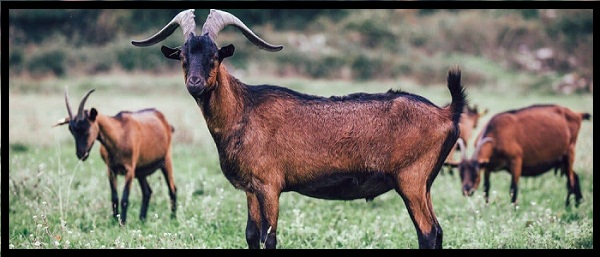
What are the popular five breeds of goat in Nigeria?
What are the popular five breeds of goat in Nigeria? Nigeria is one of the largest producers of goat meat in Africa, and goat farming is a common practice in the country. However, goats are highly valued for their meat, milk, and skin, and there are many breeds of goats in Nigeria. In this article, we will take a look at the five most popular breeds of goats in Nigeria, including their characteristics, advantages, and uses. Whether you’re a farmer looking to start a goat farm or simply curious about the different breeds of goats in Nigeria, this article will provide you with valuable insights.
Contents
- 1 Cessummit.com Biz. Start-up Tips:
- 1.1 What are the popular five breeds of goat in Nigeria?
- 1.2 A Brief overview of goat farming in Nigeria:
- 1.3 What are the popular five breeds of goat in Nigeria?
- 1.4 What are the popular five breeds of goat in Nigeria?
- 1.5 Importance of knowing popular breeds of goats
- 1.6 What are the popular five breeds of goat in Nigeria?
- 1.7 Popular breeds of goats in Nigeria:
- 1.8 The Sahelian goat:
- 1.9 Advantages and disadvantages of Sahelian goat
- 1.10 Advantages and disadvantages of Sahelian goat
- 1.11 Common uses of Sahelian goat
- 1.12 What are the popular five breeds of goat in Nigeria?
- 1.13 West African Dwarf goat:
- 1.14 What are the popular five breeds of goat in Nigeria?
- 1.15 Advantages and disadvantages of West African Dwarf goat
- 1.16 Common uses of West African Dwarf goat
- 1.17 What are the popular five breeds of goat in Nigeria?
- 1.18 Red Sokoto goat:
- 1.19 Advantages and disadvantages of Red Sokoto goat
- 1.20 Common uses of Red Sokoto goat
- 1.21 What are the popular five breeds of goat in Nigeria?
- 1.22 Alpine goat:
- 1.23 Advantages and disadvantages of Alpine goat
- 1.24 Common uses of Alpine goat
- 1.25 What are the popular five breeds of goat in Nigeria?
- 1.26 Boer goat:
- 1.27 Advantages and disadvantages of Boer goat
- 1.28 Common uses of Boer goat
- 1.29 What are the popular five breeds of goat in Nigeria?
- 1.30 The Summary of popular breeds and their characteristics:
- 1.31 What are the popular five breeds of goat in Nigeria?
- 1.32 Read Also:
- 1.33 Summing Up:
- 1.34 Share this:
- 1.35 Like this:
Cessummit.com Biz. Start-up Tips:
Commercial goat breeding is becoming increasingly popular in Nigeria, as the demand for purebred goat is on the rise. Cessummit.com develops a bankable business plan for ranches and commercial goat breeders. If you need our sell-structured dog breeding business plan then contact us at +234 905 313 0518 or cessummit0518@gmail.com for Business plans, CAC documentation, and more.
View the following related posts;
- Profitable Business Planning for Startups
- Business Planing Process for Scale-ups
- Business planning process: Approved Checklist
What are the popular five breeds of goat in Nigeria?
A Brief overview of goat farming in Nigeria:
Goat farming is a significant agricultural activity in Nigeria and has been practiced for centuries. Also, Nigeria has a large population of goats, and it is estimated that the country has about 34 million goats, making it the largest producer of goats in Africa and the third largest in the world after India and China.
In Nigeria, goat farming is popular because goats are hardy, easy to manage, and require minimal investment. They also have a high reproductive rate, which makes them profitable for small-scale farmers. Goats are mainly reared for meat, milk, and skin production.
Goat farming in Nigeria is practiced in various forms, including free-range systems, semi-intensive, and intensive systems. In the free-range system, goats are left to graze on natural pasture, while in the semi-intensive system, goats are provided with shelter, supplementary feeding, and grazing areas. In the intensive system, goats are kept in a confined space and provided with all their needs.
What are the popular five breeds of goat in Nigeria?
There are several breeds of goats in Nigeria, including the West African Dwarf, Red Sokoto, Sahelian, and the Anglo-Nubian. Each breed has its unique characteristics and is suited for specific purposes.
The challenges facing goat farming in Nigeria include inadequate veterinary services, poor feeding, and management practices, and lack of access to markets. However, with the growing demand for goat meat, milk, and skin, there are opportunities for farmers to increase their income by improving their goat farming practices and accessing markets both locally and internationally.
What are the popular five breeds of goat in Nigeria?
Importance of knowing popular breeds of goats
Knowing the popular breeds of goats is essential for several reasons, including:
- Selecting the right breed for a particular purpose: Different goat breeds have unique characteristics that make them suited for specific purposes, such as meat production, milk production, or fiber production. By knowing the popular breeds, farmers can select the breed that is best suited for their intended purpose.
- Understanding the management requirements: Different goat breeds have different management requirements, such as feeding, housing, and health care. By knowing the popular breeds, farmers can understand the specific needs of the breed and provide appropriate management practices.
- Breeding and genetics: Knowledge of popular goat breeds is also essential for breeding and genetics purposes. By selecting the right breed for breeding, farmers can improve the genetic traits of their herd, such as milk production, growth rate, and disease resistance.
- Marketing: Knowing the popular goat breeds in a particular area can also help farmers in marketing their products. For example, if a particular breed of goat is in high demand for meat or milk production in the local market, farmers can focus on raising that breed to meet the demand and increase their income.
In summary, knowing the popular goat breeds is crucial for selecting the right breed for a specific purpose, understanding their management requirements, improving breeding and genetics, and marketing their products.
What are the popular five breeds of goat in Nigeria?
Popular breeds of goats in Nigeria:
The following are the popular breed of goats in Nigeria.
- Sahelian goat
- West African Dwarf goat
- Red Sokoto goat
- Alpine goat
- Boer goat
The Sahelian goat:
Description and characteristics of Sahelian goat
The Sahelian goat is a breed of domestic goat that originated in the Sahel region of West Africa, which includes countries such as Mali, Niger, Chad, and Senegal. This breed is well adapted to the hot and dry climate of the Sahel, where temperatures can reach over 40°C (104°F) during the day and drop below 20°C (68°F) at night.
Here are some characteristics of the Sahelian goat:
- Appearance: The Sahelian goat is a medium-sized breed with a slender body and long legs. It has a short, glossy coat that can range in color from light brown to white, with black or brown markings on the head and neck. Both males and females have long, curved horns.
- Adaptability: The Sahelian goat is well adapted to the harsh conditions of the Sahel, where food and water can be scarce. They have a high tolerance for heat and are able to survive for long periods of time without water.
- Diet: Sahelian goats are mainly browsers, feeding on leaves, twigs, and shrubs. They also graze on grasses, but prefer the leaves and shoots of plants. In times of drought, they are able to survive on low-quality forage.
- Reproduction: Sahelian goats have a high reproductive rate, with females able to produce 2-3 kids per year. They reach sexual maturity at around 6 months of age and can breed year-round.
Advantages and disadvantages of Sahelian goat
- Milk production: Although not known for their milk production, Sahelian goats are able to produce an average of 1-2 liters of milk per day, with a high butterfat content.
- Economic value: Sahelian goats are an important source of food and income for many people in the Sahel region. They are often raised in small-scale, subsistence farming systems and are sold for meat, milk, and skins.
Overall, the Sahelian goat is a hardy and adaptable breed that plays an important role in the livelihoods of many people in West Africa.
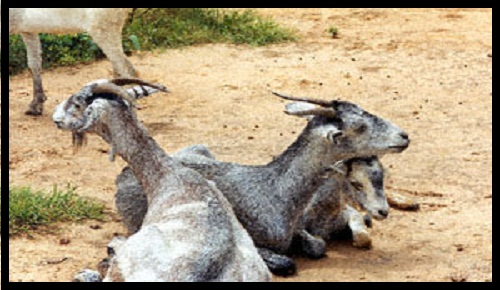
Advantages and disadvantages of Sahelian goat
Advantages of Sahelian goat:
- Adaptability: Sahelian goats are well adapted to the hot and dry climate of the Sahel region, which makes them suitable for raising in areas where other livestock may not survive.
- High reproductive rate: These goats have a high reproductive rate and can breed year-round, which means that farmers can quickly build up their herd size and increase their income.
- Meat production: Sahelian goats are an important source of meat, and their meat is lean, flavorful, and nutritious.
- Low input costs: They require minimal input in terms of feed, housing, and veterinary care, which makes them an ideal livestock species for small-scale and subsistence farmers.
Disadvantages of Sahelian goat:
- Limited milk production: Although Sahelian goats are capable of producing milk, their milk production is generally low compared to other dairy breeds, which limits their potential for dairy farming.
- Small size: Sahelian goats are a relatively small breed, which means that they may not be as economically viable for meat production as larger breeds.
- Disease susceptibility: They are susceptible to a range of diseases, including parasitic infections and respiratory diseases, which can affect their growth and productivity.
- Predation: The Sahelian goat is vulnerable to predation by wild animals such as lions, hyenas, and leopards, which can lead to significant losses for farmers.
Overall, Sahelian goats are hardy and adaptable livestock species that have a range of benefits for farmers in the Sahel region, but also have some limitations that need to be considered when raising them.
Common uses of Sahelian goat
Sahelian goats have several common uses, including:
- Meat production: Sahelian goats are primarily raised for their meat, which is lean, flavorful, and nutritious. They are slaughtered for meat at various stages of their life, depending on the market demand and the purpose of the meat.
- Milk production: Although not known for their milk production, Sahelian goats are able to produce an average of 1-2 liters of milk per day, which can be used for consumption or for making cheese and other dairy products.
- Skin and hide production: The skin and hide of Sahelian goats are used to make leather products such as shoes, bags, and belts.
- Fertilizer production: The manure of Sahelian goats can be used as a natural fertilizer to improve soil fertility and crop yields.
- Cultural and social purposes: In some parts of West Africa, Sahelian goats are used for cultural and social purposes, such as for bride price or as sacrificial animals during religious festivals.
Overall, the common uses of Sahelian goats are diverse and play an important role in the livelihoods of many people in the Sahel region.
What are the popular five breeds of goat in Nigeria?
West African Dwarf goat:
Description and characteristics of West African Dwarf goat
The West African Dwarf goat (WAD) is a breed of domestic goat indigenous to West Africa. It is a small-sized goat, typically weighing between 20 to 50 kg (44 to 110 lbs) and standing at 40 to 50 cm (16 to 20 inches) tall at the shoulder.
The breed is well adapted to its native tropical climate, with a short, fine coat that varies in color from white, black, brown, to a combination of these colors. They are also known for their hardiness and resistance to various diseases, making them a popular choice for subsistence farming and small-scale agriculture.
WAD goats are primarily raised for meat and milk production, and are known for their high-quality meat with a distinct flavor. They are also good milk producers, with an average yield of about 0.5 to 1.5 liters per day, and their milk is rich in nutrients such as protein, calcium, and vitamins.
What are the popular five breeds of goat in Nigeria?
WAD goats are social animals and thrive in groups. They are known for their docile temperament and easy handling, which makes them suitable for small-scale farming and household use. Due to their adaptability, hardiness, and high productivity, the West African Dwarf goat is a valuable breed for sustainable livestock production and economic development in many regions of West Africa.
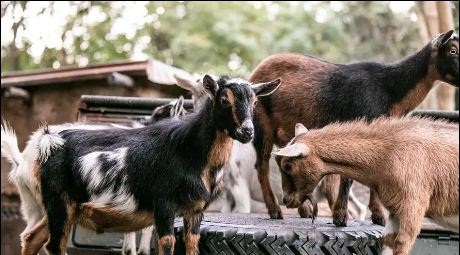
Advantages and disadvantages of West African Dwarf goat
Advantages:
- Adaptability: West African Dwarf goats are well adapted to the tropical climate of West Africa, which makes them a good choice for farmers in the region. They can thrive in harsh environmental conditions and are resistant to various diseases.
- Productivity: WAD goats are good milk producers, and their milk is high in nutrients such as protein, calcium, and vitamins. They also produce high-quality meat with a distinct flavor.
- Easy to Handle: These goats are docile and easy to handle, making them suitable for small-scale farming and household use.
- Cost-effective: WAD goats are low-cost animals to raise, and their small size means they require less feed and space than larger breeds.
Disadvantages:
- Small size: While their small size is an advantage in terms of feed and space requirements, it also means that they produce less meat and milk than larger breeds.
- Limited genetic diversity: The West African Dwarf goat is a relatively homogeneous breed, which means that there is limited genetic diversity. This can lead to inbreeding and increased susceptibility to certain diseases.
- Market demand: The market demand for WAD goats may be limited, particularly in areas where larger breeds are preferred for meat and milk production.
- Reproductive challenges: WAD goats can have reproductive challenges, including low fertility and high mortality rates in newborn kids, which can impact productivity.
Common uses of West African Dwarf goat
The West African Dwarf goat is primarily used for meat and milk production, as well as for its skin and manure. Here are some common uses of WAD goats:
- Meat production: WAD goats are known for their high-quality meat with a distinct flavor. They are commonly raised for meat production, and their meat is used for food in various regions of West Africa.
- Milk production: WAD goats are good milk producers, with an average yield of about 0.5 to 1.5 liters per day. Their milk is high in nutrients such as protein, calcium, and vitamins, and is used for consumption and local processing.
- Skin and fiber production: The skin of WAD goats is used for leather production, while their fiber is used for the production of textiles.
- Manure production: The manure of WAD goats is a valuable fertilizer, which can be used to improve soil fertility and increase crop yields in small-scale agriculture.
- Cultural and ceremonial purposes: In some regions of West Africa, WAD goats are also used for cultural and ceremonial purposes, such as for dowries, sacrifices, and as gifts during important events.
What are the popular five breeds of goat in Nigeria?
Red Sokoto goat:
Description and characteristics of Red Sokoto goat
Red Sokoto goat, also known as Maradi or West African Dwarf goat, is a breed of goat that originated in West Africa, specifically in the Sahel region, which includes countries such as Nigeria, Niger, Chad, and Cameroon. They are named after Sokoto State, a region in Nigeria where they are commonly found.
Here are some characteristics of Red Sokoto goats:
- Size: They are a small-sized breed of goat, with adult males weighing between 20 to 30 kg, and adult females weighing between 15 to 25 kg.
- Coat: They have a distinctive red/brown coat color, with short, shiny hair.
- Horns: Both males and females have horns, which are small and curved, growing up to 15 cm in length.
- Adaptability: They are highly adapted to living in arid and semi-arid regions, and are able to withstand extreme temperatures and harsh climatic conditions.
- Feeding habits: Red Sokoto goats are browsers and feed on a wide variety of plants, including leaves, shrubs, and small trees.
- Reproduction: They have a high reproductive rate, with females reaching sexual maturity at around six months of age and having a gestation period of about five months. They can give birth to twins or even triplets.
- Meat quality: Red Sokoto goats are highly valued for their meat, which is tender and flavorful.
Overall, Red Sokoto goats are a hardy breed that are well-suited to the harsh conditions of their native environment, and are highly valued for their meat and milk production.
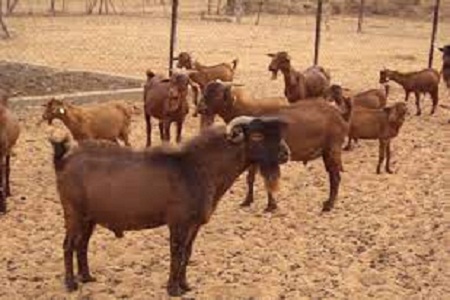
Advantages and disadvantages of Red Sokoto goat
Advantages of Red Sokoto Goat:
- Adaptability: Red Sokoto goats are highly adaptable to harsh environmental conditions, making them suitable for living in arid and semi-arid regions.
- High Reproductive Rate: Red Sokoto goats have a high reproductive rate, with females giving birth to twins or even triplets.
- Disease Resistance: They have good resistance to diseases, which makes them easy to manage and maintain.
- Good Meat Quality: The meat of Red Sokoto goats is tender and flavorful, making it highly desirable.
- Easy to Maintain: They are relatively easy to maintain since they can feed on a variety of plants and do not require much space.
Disadvantages of Red Sokoto Goat:
- Small Size: They are a small-sized breed, which limits their commercial value in the meat industry.
- Low Milk Yield: The milk yield of Red Sokoto goats is relatively low, which limits their commercial value in the dairy industry.
- Slow Growth Rate: They have a slow growth rate, which means it takes longer for them to reach market weight.
- Limited Distribution: Red Sokoto goats are primarily found in West Africa, which limits their availability in other regions.
- Predation: They are susceptible to predation by wild animals, which can be a problem for farmers who raise them in open-range systems.
Overall, Red Sokoto goats have many advantages that make them suitable for small-scale farming, but their small size and slow growth rate may limit their commercial value in larger-scale operations.
Common uses of Red Sokoto goat
Red Sokoto goats have several uses, including:
- Meat production: Red Sokoto goats are primarily raised for their meat, which is tender and flavorful. They are slaughtered for meat once they reach market weight, which is usually between 6-12 months.
- Milk production: Although their milk yield is relatively low. Red Sokoto goats are still used for milk production, particularly in small-scale dairy operations.
- Breeding: They are used for breeding purposes to produce offspring that exhibit desirable traits. Traits such as high disease resistance, good growth rates, and good meat quality.
- Cultural and religious purposes: Red Sokoto goats have cultural and religious significance in some West African communities. They are used for traditional ceremonies and sacrifices.
- Biomedical research: Red Sokoto goats are used in biomedical research due to their high disease resistance and adaptability to harsh environmental conditions.
Overall, Red Sokoto goats are a versatile breed that have a range of uses, but their primary use is for meat production
What are the popular five breeds of goat in Nigeria?
Alpine goat:
Description and characteristics of Alpine goat
The Alpine goat is a breed of domestic goat that is known for its hardiness and versatility. It is a medium to large-sized breed that originated in the French Alps but is now found all over the world. Here are some of the characteristics of the Alpine goat:
- Appearance: The Alpine goat has a distinctive appearance with its erect ears, alert expression, and straight nose. It has a sturdy, muscular build and a short, glossy coat that can come in a variety of colors such as black, brown, gray, and white.
- Size: Alpine goats are medium to large-sized goats. The does typically weigh between 120 to 170 pounds, while the bucks can weigh between 170 to 240 pounds.
- Temperament: Alpine goats are known for their friendly and outgoing personalities. They are curious and intelligent animals that are easy to handle and train.
- Milk production: Alpine goats are one of the top milk-producing breeds of goats. They can produce up to 1 gallon of milk per day, which is high in butterfat and protein.
- Adaptability: Alpine goats are very adaptable and can thrive in a variety of environments. They are hardy and can tolerate cold weather as well as hot, dry climates.
- Diet: Alpine goats are ruminants, which means they have a four-chambered stomach and require a diet of roughage such as hay and grass. They also need access to clean water and minerals.
Overall, the Alpine goat is a hardy and versatile breed that is popular among farmers and homesteaders for its milk production, friendly temperament, and adaptability.

Advantages and disadvantages of Alpine goat
Advantages of Alpine Goats:
- Milk Production: Alpine goats are excellent milk producers, and they can produce up to a gallon of milk per day. The milk is rich in butterfat and protein, making it ideal for cheese and butter production.
- Adaptability: Alpine goats are hardy and adaptable, and they can thrive in a variety of climates and environments. They are resistant to diseases and parasites, making them a low-maintenance animal.
- Docile temperament: Alpine goats are known for their friendly and outgoing personalities, making them easy to handle and work with. They are also intelligent and easy to train.
- Versatility: Alpine goats are used for a variety of purposes, including milk production, meat production, and as pets or companion animals.
Disadvantages of Alpine Goats:
- High Energy: Alpine goats are active and high-energy animals, and they require a lot of space to roam and exercise. They are not well-suited for confinement.
- Feed Requirements: Alpine goats require a diet of roughage such as hay and grass, as well as access to clean water and minerals. They can be expensive to feed, especially during the winter months.
- Space Requirements: Alpine goats require a lot of space to roam and exercise, and they can be destructive if they are confined to a small area.
- Health Issues: Alpine goats are susceptible to a variety of health issues, including mastitis, respiratory infections, and parasitic infestations. Regular health checks and preventative measures are required to keep them healthy.
Overall, the advantages of Alpine goats, such as their milk production, adaptability, and docile temperament, outweigh the disadvantages. However, they do require adequate space, feed, and health care to thrive.
Common uses of Alpine goat
The Alpine goat is a versatile breed of domestic goat that has a variety of uses. Here are some of the most common uses of Alpine goats:
- Milk Production: Alpine goats are known for their high milk production, which is rich in butterfat and protein. They are often used for commercial milk production as well as for home dairies to make cheese, butter, and other dairy products.
- Meat Production: Alpine goats can also be raised for their meat. They produce lean, flavorful meat that is popular in many cuisines.
- Companion Animals: Alpine goats are often kept as pets or companion animals because of their friendly and outgoing personalities. They are intelligent, curious, and easy to train, making them great pets for families.
- Brush Control: Alpine goats are used for brush control in many areas, including parks, highways, and private properties. They are natural grazers and can help to control the growth of invasive plants and shrubs.
- Show Animals: Alpine goats are popular show animals in 4-H and other livestock shows. They are judged based on their appearance, size, and other characteristics.
Overall, the Alpine goat is a versatile breed that can be used for a variety of purposes. Uses includes milk and meat production, as pets, for brush control, and as show animals.
What are the popular five breeds of goat in Nigeria?
Boer goat:
Description and characteristics of Boer goat
Boer goats are a breed of domestic goats first developed in South Africa in the early 1900s for meat production. However, they are named after the Dutch word “boer” which means farmer. Boer goats are now widely bred in many countries around the world, including the United States, Australia, and New Zealand.
Here are some characteristics of Boer goats:
- Appearance: Boer goats are large, muscular animals with a distinctive white body and a reddish-brown head. They have long, droopy ears and horns that curve backwards.
- Size: Boer goats are a large breed, with males (bucks) weighing between 240 and 300 pounds and females (does) weighing between 200 and 220 pounds.
- Adaptability: Boer goats are hardy animals that are well-adapted to a wide range of environments. They are able to thrive in hot, dry conditions and are also able to tolerate cold weather.
- Reproduction: Boer goats have a high fertility rate and are able to produce large litters of kids (baby goats). They are also known for their excellent mothering abilities.
- Meat quality: Boer goats are primarily raised for meat production, and are known for their lean meat with a mild flavor.
- Docile nature: Boer goats are generally known for their friendly and docile nature, which makes them easy to handle and work with.
Overall, Boer goats are a hardy, adaptable breed that are prized for their meat quality and docile nature.
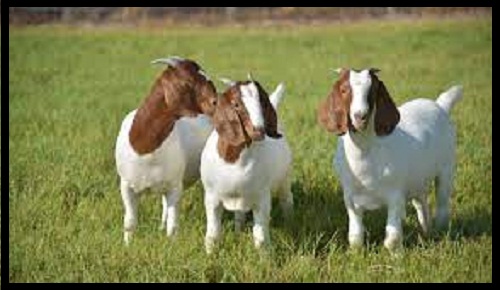
Advantages and disadvantages of Boer goat
Advantages of Boer goat:
- High meat yield: Boer goats are primarily raised for their meat, which has a high yield and quality.
- Disease resistance: Boer goats have a high level of resistance to many common goat diseases. Also, this reduces the need for expensive medical treatments.
- Adaptability: Boer goats are well-adapted to a wide range of environments and can thrive in both hot and cold conditions.
- High fertility rate: Boer goats have a high fertility rate. They are able to produce large litters of kids, which makes them an attractive option for commercial meat production.
- Docile nature: Boer goats are generally known for their friendly and docile nature. Also, which makes them easy to handle and work with.
Disadvantages of Boer goat:
- High initial investment: Boer goats can be expensive to purchase. This can make it difficult for small-scale farmers to get started.
- High feed requirements: Boer goats have a high feed requirement, which can increase the cost of raising them.
- Limited milk production: Boer goats are primarily raised for meat production and have a relatively low milk production. This limits their use as a dairy animal.
- Horns: Boer goats have large, curved horns that can be dangerous to humans and other animals if they are not properly handled.
- Environmental impact: Like all livestock, Boer goats can have an impact on the environment if they are not managed properly. They can cause soil erosion and contribute to water pollution if they are allowed to graze in sensitive areas.
Common uses of Boer goat
The Boer goat is primarily used for meat production, as its meat has a high yield and quality. However, there are other uses of Boer goats as well. Here are some common uses of Boer goat:
- Meat production: Boer goats are primarily raised for their meat. They are known for their lean meat with a mild flavor, and commonly used for meat production around the world.
- Breeding: Boer goats are also used for breeding purposes, as they have a high fertility rate and are able to produce large litters of kids.
- Show animals: Boer goats are popular show animals due to their attractive appearance and docile nature.
- Vegetation management: Boer goats are sometimes used for vegetation management. Because they are able to clear land of unwanted vegetation such as brush and weeds.
- 4-H and FFA projects: Boer goats are often used for 4-H and FFA (Future Farmers of America) projects, as they are easy to handle and care for.
- Petting zoos: Boer goats are popular animals for petting zoos and other educational exhibits, as they are friendly and docile.
Overall, the primary use of Boer goats is for meat production, but they have other uses as well. These includes breeding, show animals, vegetation management, and educational exhibits
What are the popular five breeds of goat in Nigeria?
The Summary of popular breeds and their characteristics:
Here are some popular breeds of goats and their characteristics:
- Boer goats: Originally from South Africa, Boer goats are bred for meat production. They are muscular, have a high growth rate, and are adaptable to a variety of environments.
- Alpine goats: Alpine goats are known for their milk production, producing an average of 1-2 gallons per day. They are hardy, adaptable, and come in a variety of colors.
- Nubian goats: Nubian goats are a popular breed for both milk and meat production. They have long, floppy ears and are known for their high butterfat content in their milk.
- LaMancha goats: LaMancha goats are a dairy breed known for their mild temperament and high milk production. They are easily recognizable by their very short ears.
- Saanen goats: Saanen goats are a dairy breed that are known for their high milk production and docile personalities. They are usually all-white and have erect ears.
- Spanish goats: Spanish goats are a hardy breed that are known for their meat production. They are adaptable to a variety of environments and are resistant to many diseases.
- Kiko goats: Kiko goats are bred for meat production and are known for their hardiness and adaptability. Also, they are originally from New Zealand and are often used for brush clearing.
- Nigerian Dwarf goats: Nigerian Dwarf goats are a small dairy breed known for their high butterfat content in their milk. They are popular as pets and for small-scale milk production.
These are just a few examples of popular breeds of goats and their characteristics. When selecting a breed for your farm, it’s important to consider your specific needs and resources to choose a breed that will be well-suited to your operation.
What are the popular five breeds of goat in Nigeria?
Read Also:
- 10 Low-Cost Business Ideas for Aspiring Entrepreneurs
- Identification of business opportunities: A Global Approach
- Frugal Entrepreneurship: 5 Low-Cost Business Ideas You Can Start Today
- Checklist of Authentic business licenses and permits
- Starting a Profitable Goat Farming Business in Nigeria
- Profitable Business Planning for Startups
- Cessummit.com Services Offerings: What we do & How
- Profitable Business Ideas
Summing Up:
In Nigeria, there are several breeds of goats, but some of the most popular ones are the West African Dwarf, Red Sokoto, Sahelian, Pygmy, and Boer goats. Each of these breeds has its unique characteristics and is well adapted to different climates and environments in Nigeria. The West African Dwarf goat is known for its hardiness and adaptability. While the Red Sokoto is valued for its high-quality meat. The Sahelian goats are favored for their milk production. While the Pygmy and Boer goats are popular for their meat production. These breeds have played an essential role in the livelihoods of many Nigerians. It has also continue to be a valuable asset to the country’s economy.






